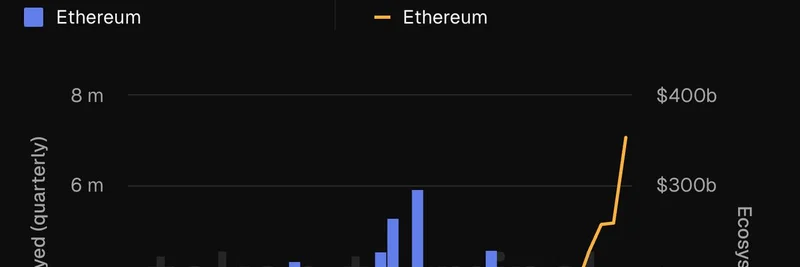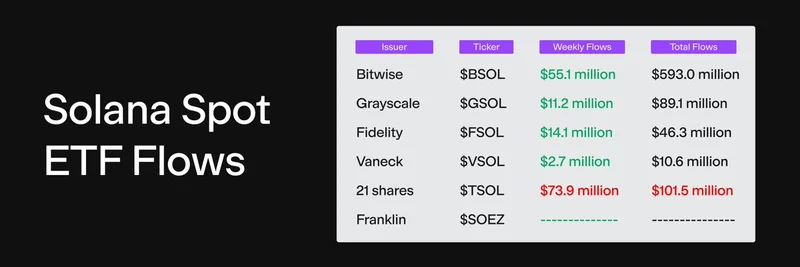Ethereum's Layer 1 (L1) is undergoing a fascinating transformation, solidifying its role as a powerhouse for high-value financial applications. According to a recent post from Token Terminal, while the total value locked (TVL) in the ecosystem continues to climb, the pace of new smart contract deployments—a strong signal of developer experimentation and fresh ideas—has been on a downward trajectory. This shift suggests Ethereum is maturing into a more stable platform for serious finance, but it might be coming at the cost of the wild innovation that once defined it.
Looking at the chart, you can see the blue bars representing quarterly contract deployments peaking around 2021-2022 before tapering off. Meanwhile, the orange line for TVL shows a steady upward trend, recently pushing toward $400 billion. TVL, for those new to the term, measures the total amount of assets locked in protocols on the blockchain—think of it as a gauge of economic activity and trust in the network.
Token Terminal argues that reigniting innovation on Ethereum L1 could lead to explosive growth, potentially multiplying TVL by 10 to 100 times. That's a bold claim, but it's backed by the idea that Ethereum's current setup prioritizes security and value over rapid experimentation. Meme tokens, which often thrive on quick deployments and viral ideas, might feel this slowdown the most, as developers migrate to faster, cheaper layers or alternative chains.
The Path to Re-Enabling Innovation: Real-Time Proving Breakthroughs
The post quotes insights from Justin Drake, a prominent Bitcoin security researcher, who highlights rapid progress in real-time proving for Ethereum L1. Real-time proving involves using zero-knowledge (zk) proofs to verify transactions almost instantly, making the network more efficient and scalable without sacrificing decentralization.
Drake points out extraordinary advancements: Just five months ago, systems like SP1 Hypercube needed 160 high-end GPUs to prove most L1 blocks in under 12 seconds. Now, Pico Prism achieves even better results with only 64 GPUs, averaging 6.9 seconds. This isn't just incremental—it's outpacing Moore's Law, the famous prediction about computing power doubling every two years.
What's exciting is the diversity in zk virtual machines (zkVMs) racing to make this a reality: Airbender, Ceno, Jolt, and others. This variety strengthens the ecosystem, much like having multiple clients for Ethereum's consensus and execution layers.
Upcoming upgrades like Fusaka in December, along with Ethereum Improvement Proposals (EIPs) such as 7825, 7823, and 7883, aim to simplify proving and handle high-gas operations more efficiently. By year's end, teams could prove every L1 block on a modest 16-GPU setup using less than 10kW of power—about what a home EV charger draws. This democratizes proving, allowing it to run in everyday setups rather than massive cloud farms.
Scaling Ethereum: From Gigagas to Teragas
Drake envisions Ethereum hitting "gigagas" throughput on L1—that's a 100x increase from today's levels, enabling 10,000 transactions per second (TPS) directly on mainnet. For context, current L1 handles around 2 megagas per second, up from 20 kilogas at launch a decade ago. Layer 2 (L2) solutions could push to "teragas," supporting 10 million TPS and onboarding global finance.
This leaner Ethereum also boosts decentralization. Heavy hardware requirements could drop, letting even a Raspberry Pi or smartphone validate the network statelessly. Say goodbye to the scalability-decentralization trade-off that's plagued blockchains.
A highlight is the upcoming Ethproofs demo at Devconnect Argentina in November, where Drake plans to run his home validator solely on zkEVM proofs, ditching traditional execution clients. It's being called Ethereum's "lightbulb moment," akin to historic inventions unveiled at world fairs.
Implications for Meme Tokens and the Broader Crypto Space
For meme token enthusiasts, this could be a game-changer. If L1 becomes more accessible for experimentation again, we might see a resurgence of creative, community-driven projects without relying solely on L2s. High-value finance on Ethereum provides a stable foundation, but innovation is the spark that drives adoption—especially in the volatile world of memes.
Token Terminal's analysis underscores a pivotal moment for Ethereum. As it consolidates its strengths in finance, these technological leaps could unlock the next era of growth. Whether you're a developer, investor, or just crypto-curious, keeping an eye on these trends is key to understanding where the blockchain space is headed.
If you're diving into meme tokens on Ethereum or exploring L2 options, check out our knowledge base for more insights on the latest trends and tools to stay ahead.


